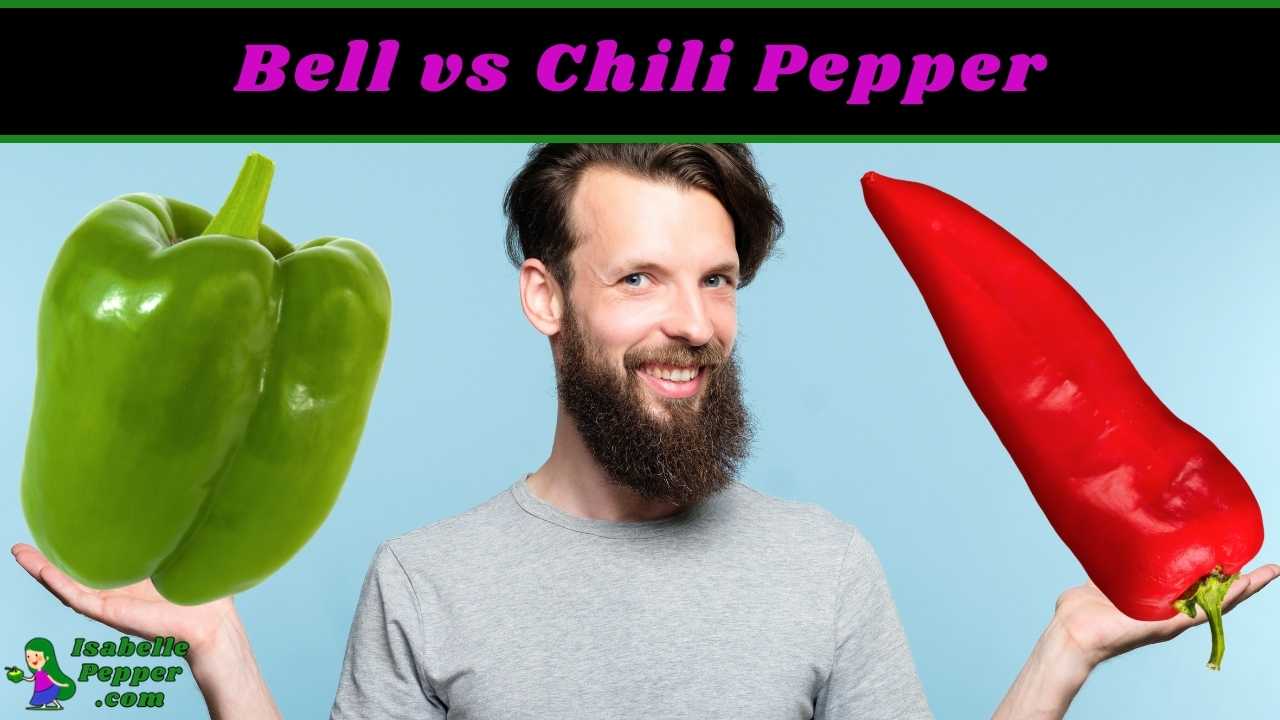Bell peppers showcase a stunning array of colors, from vibrant green to fiery red, sunny yellow, and even regal purple and white.
But what gives rise to this remarkable spectrum of hues? The answer lies in the fascinating journey of bell peppers from the vine to your plate.
Join us as we unravel the captivating story behind the diverse colors of bell peppers and explore the intriguing reasons that make each hue distinct.
From flavor variations to nutritional differences, discover why the world of bell peppers is not only a visual delight but also a testament to nature’s intricate wonders.

Variety of Bell Pepper Colors
Step into any grocery store’s produce section, and you’ll be met with an enticing display of bell peppers in various shades – green, red, yellow, and orange, to name a few.
While these peppers may appear distinct, they all share a common origin.
Bell peppers, scientifically known as Capsicum annuum, start their journey as green peppers and transform into a spectrum of colors as they ripen and mature.
The variations in color are not arbitrary; they signify different stages of development and offer unique taste and nutritional profiles.
Factors Influencing Bell Pepper Color
Ripeness and Maturation:
The process of color transformation in bell peppers is closely tied to their degree of ripeness.
Green bell peppers are the earliest stage, harvested before full maturation. As they stay on the plant, they progress through shades of yellow, orange, and ultimately red.
The duration of time on the vine plays a crucial role in determining the color and taste of the pepper.
There are a few additional factors that may influence a bell peppers growth and ripeness. I created a full guide that you can read here: Bell Pepper Growth Explained
Varietal Differences:
Not all bell peppers follow the same color trajectory.
Some varieties transition from green to yellow or orange, while others remain green throughout their development. Some are even purple or white!
The fascinating interplay between genetics and environmental conditions contributes to the diversity of colors in bell peppers.
Green vs Yellow vs Orange vs Red vs Purple vs White Bell Peppers
| Factor | Green Bell Pepper | Red Bell Pepper | Yellow Bell Pepper | Orange Bell Pepper | Purple Bell Pepper | White Bell Pepper |
|---|---|---|---|---|---|---|
| Flavor | Grassy, Bitter | Sweet, Juicy | Sweet, Fruity | Sweet, Fruity | Sweet, Mild | Mild, Subtle |
| Vitamin C | High | Very High | High | High | High | Moderate |
| Beta-Carotene | Low | High | Moderate | Moderate | Moderate | Low |
| Vitamin A | Low | Very High | Moderate | High | Moderate | Low |
| Potassium | Moderate | Moderate | Moderate | Moderate | Moderate | Low |
| Fiber | Moderate | Moderate | Moderate | Moderate | Moderate | Moderate |
| Antioxidant Content | Lower | Higher | Moderate | Moderate | Moderate | Moderate |
| Price | Affordable | Expensive | Moderate | Moderate | Varies | Varies |
| Cooking Applications | Versatile | Versatile | Versatile | Versatile | Roasting, Grilling | Roasting, Grilling |
| Digestibility | Generally Easy | Generally Easy | Generally Easy | Generally Easy | Generally Easy | Generally Easy |
| Heat Level (Scoville Heat Units) | Mild | Mild | Mild | Mild | Mild | Mild |
Nutritional Variations Among Bell Pepper Colors
Nutrient Content in Green Bell Peppers:
Green bell peppers, commonly chosen for their milder taste, exhibit a distinct nutrient profile.
While they lack the vibrant hues of their ripe counterparts, they still provide essential nutrients such as vitamin C, vitamin K, and dietary fiber.
Nutrient Enhancement with Ripening:
As bell peppers mature and change color, their nutritional composition undergoes a transformation.
Red bell peppers, having spent the most time on the vine, emerge as nutritional powerhouses.
They boast significantly higher levels of vitamin C, vitamin A, and beta-carotene compared to their green counterparts.
Specific Nutrients in Different Colors:
The transition from green to red involves an increase in nutrients such as lycopene and capsanthin, which contribute to the peppers’ vivid color and antioxidant properties.
Yellow and orange bell peppers also pack a nutritional punch, offering a balance between the vibrancy of red peppers and the subtlety of green ones.
Flavor Profiles and Culinary Uses
Taste Differences Based on Ripeness:
Bell pepper taste profiles evolve with ripeness.
Green bell peppers exhibit a mildly bitter and grassy flavor, offering a delightful contrast to sweeter and richer ingredients.
As peppers progress to shades of yellow, orange, and red, their taste becomes progressively sweeter, juicier, and less bitter.
Culinary Uses of Green, Red, Yellow, and Orange Bell Peppers:
Each bell pepper color lends itself to different culinary applications.
Green peppers, with their sturdy texture and distinct taste, are often preferred for cooking and sautéing.
In contrast, red, yellow, and orange peppers shine in raw preparations, adding a burst of natural sweetness to salads and snacks.
Color and Price Differences
Red Bell Peppers’ Higher Price:
A common question that arises is why red bell peppers tend to be more expensive than their green counterparts.
The answer lies in their extended time on the plant.
Red bell peppers require additional care and resources as they ripen to their full potential, resulting in a sweeter and more nutrient-rich fruit that justifies their higher price tag.
Yellow and Orange Bell Peppers’ Intermediary Position:
Yellow and orange bell peppers strike a balance between green and red varieties.
They offer a compromise between cost, taste, and nutritional benefits.
Economical Aspects of Green Bell Peppers:
Green bell peppers, harvested earlier in their development, are more economical to produce and consequently come at a lower price point.
You can learn more about why different colored bell peppers have different prices by reading this article by simplyrecipes.com
Varieties and Uncommon Colors
Beyond the primary color spectrum, bell peppers can surprise us with an array of uncommon hues.
Shades of purple, brown, white, and even lavender peppers can be found, albeit less frequently.
These unique colors are often the result of specific pigments and compounds present in the peppers.
FAQs
How Many Different Color Bell Peppers Are There?
There are seven different color bell peppers: green, red, yellow, orange, purple, white, and brown. Each color either represents a specific stage of ripeness or is a result from specific pigments and compounds present in the peppers.
What Is the Most Popular Bell Pepper Color?
Green bell peppers are often favored for their familiar and slightly bitter flavor, as well as their versatility in various dishes and cuisines. Additionally, they tend to be more budget-friendly than some of the riper-colored bell peppers, making them a practical choice for many consumers.
What Color Bell Pepper Is Most Expensive?
Red bell peppers are typically the most expensive among the various colors of bell peppers. This higher cost is often attributed to the longer time they require to fully ripen on the vine, resulting in a sweeter flavor and higher nutritional content compared to their less mature counterparts.
What Color Bell Pepper Lasts the Longest?
Green bell peppers tend to have a longer shelf life compared to other colors. This is because they are harvested at an earlier stage of ripeness, which makes them less prone to spoilage and allows them to stay fresh for a longer period of time.
What Color Bell Pepper Is Best for Cooking?
Red bell peppers are sweeter and often preferred for raw consumption, while green bell peppers are commonly used for cooking due to their slightly bitter and more robust flavor. If you’re looking for a bell pepper to enhance the flavor of your cooked dishes, green bell peppers are a popular choice.
What Color Bell Pepper Is the Sweetest?
Red bell peppers are the sweetest among the different color bell peppers.
Which Color Bell Pepper Is the Hottest?
Heirloom bell peppers, including the various colors, do not contain capsaicin and are not considered hot. Hybrid varieties like the Cajun Belle may have some level of spiciness due to their capsaicin content.
Which Color Bell Pepper Is the Healthiest?
Red bell peppers are often considered the healthiest due to their higher nutrient content, including vitamin C, vitamin A, and antioxidants.
Which Color of Bell Pepper Has the Most Vitamin A?
Red bell peppers have the highest vitamin A content among bell pepper colors.
Which Color Bell Pepper Has the Most Potassium?
Red bell peppers have the highest potassium content among bell pepper colors.
What Color Bell Pepper Has the Most Fiber?
Ripened bell peppers (red) typically contain more fiber than their unripe counterparts.
Which Color Bell Pepper Is Easiest to Digest?
The outer skin of green bell peppers is tougher and more fibrous, making them harder to digest. Red bell peppers are often considered the easiest to digest among different color bell peppers, thanks to their mature and fully ripened state.
Does It Matter What Color Bell Pepper You Use?
Yes, the color matters. Each color bell pepper has a distinct flavor, nutritional content, and best use in cooking.
Conclusion
In the vibrant world of bell peppers, colors offer more than just visual variety.
From the crisp bitterness of green to the succulent sweetness of red, each hue signifies a unique flavor profile and nutritional composition.
While green, red, yellow, orange, and even lesser-known purple and white peppers share a common origin, their diverse characteristics cater to a range of culinary preferences and health goals.
Whether you’re seeking a vitamin-rich option, a milder taste, or a pop of color in your dishes, understanding the differences among bell pepper colors empowers you to elevate your meals with a rainbow of choices.





